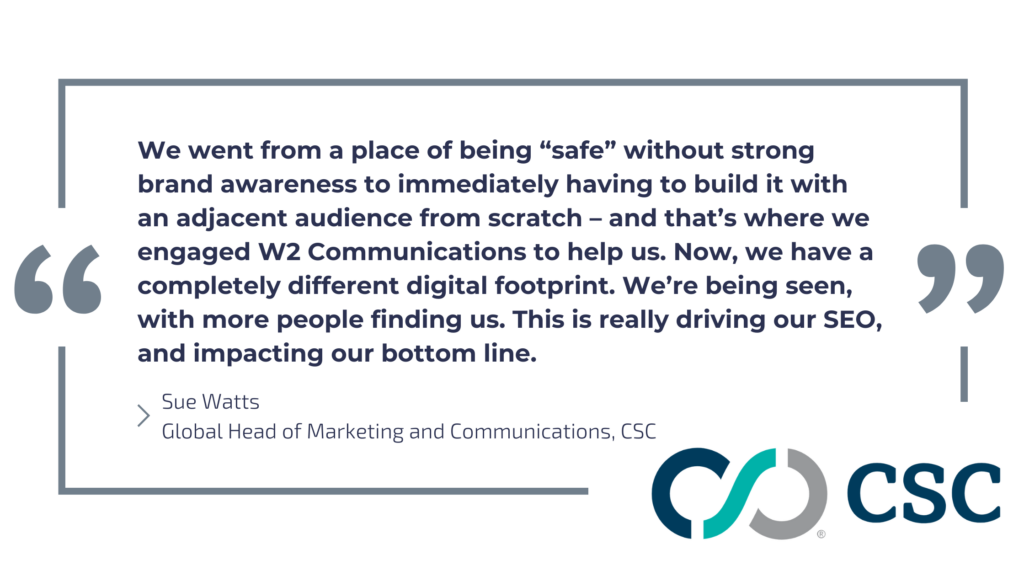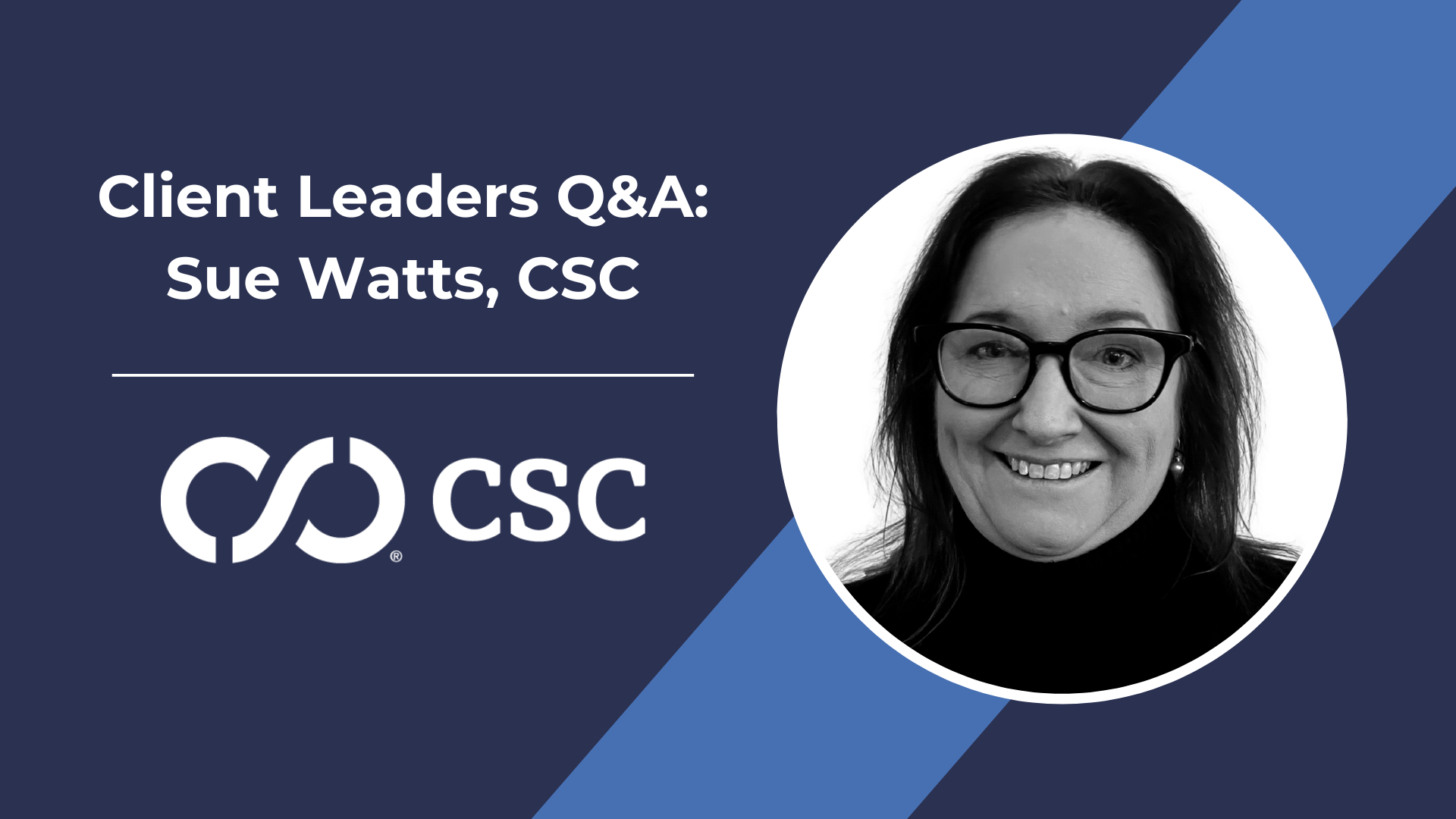If there is one certainty about the digital age, it’s that everything will change. Quickly.
As the Global Head of Marketing and Communications for CSC’s Digital Brand Services (DBS) division, Sue Watts knows this first-hand. When she arrived at the company six years ago, Watts recognized that CSC’s emergence as a cybersecurity leader in domain security and brand protection. Her task: To communicate this transformation in a compelling way to elevate CSC’s visibility among the world’s largest corporations.
We recently spoke to Watts to find out how she accomplished this – and how W2 Communications’ marketing and strategic communications services helped accelerate the journey.
In business for more than 120 years, CSC is trusted by some of the largest companies in the world for business enablement services. The CSC DBS division emerged as a trusted security and threat intelligence provider of choice for clients in the Forbes Global 2000 and the Best Global Brands (Interbrand). Focusing on domain security and management, CSC DBS enables corporate customers to protect against cyber threat vectors targeting their online assets, helping them avoid devastating revenue loss while maintaining the integrity of their brand reputation.
Watts serves as a leader in marketing and communications, with a strong emphasis on analytics and driving results. She arrived at CSC in 2019, when she created and implemented a global marketing strategy and plan for the division. Over time, she re-engineered CSC’s demand generation and improved marketing-influenced revenue by 49 percent.
During our conversation, Watts discussed marketing’s role in business transformation and brand building – and why good storytelling matters:
You have a long history as a marketer. What is the biggest challenge you’ve faced over the years?
Watts: Making sure marketing has equal footing at the seat of the leadership table for “doing the business of business.” I think there’s a really important dynamic between sales and marketing that happens when strong executive leadership understands both functions and the importance of interdependent tension between both groups for the good of the company. That knowledge even speaks to goals that marketing and communications professionals have outside of things like demand generation or company revenue, but brand awareness and building visibility for your brand, and more top-of-funnel types of marketing. That’s not something everybody necessarily understands, so you need marketing to have a seat at the table and focus from a management standpoint as a true function within the organization. If you put it under sales or the chief operating officer or some other centralized group, leadership may not pay as much attention to it as a business driver.
What marketing challenges has CSC as a brand been able to overcome?
Watts: Since I came here five years ago, I’ve strived to show our executives how strong visibility, branding, PR and content strategies can greatly boost the bottom line – and that’s one of the key things that we as a CSC marketing team have been able to show.
Our brand visibility emerged as critical. Our business is all about protecting the domains and – as an extension of that – the brands and reputations of our customers. These are some of the world’s largest corporate entities. As such, we invested a lot of time and effort building our brand visibility to ensure instant recognition and trust with our existing customers and prospects.
How did these challenges get to the point where you needed to bring in an agency like W2 Communications?
Watts: Before I came here, we were essentially a domain registrar; but we bought a couple businesses that added brand monitoring and brand protection capabilities. Then we saw malicious domains causing fraud, along with the rise of phishing incidents targeting domains. We recognized an opportunity to adjust our messaging to address customers’ changing demands and the changing direction of our business. At that time, a lot of the marketing didn’t speak to building the big picture of our business – which was branching from what was a legal or lower-end IT purchase to a higher-end cybersecurity focused purchase. We realized it would be very valuable to get in the door of companies in terms of our growing domain security capabilities.
Additionally, we realized that the clients we were talking to at that point were in marketing, legal attorneys, IP attorneys or general counsel, or network administrators. They weren’t the cybersecurity or threat intelligence professionals that we were aiming for. These groups were facing these attacks without having a good picture around their domains, their digital certificates and their DNS – everything that runs what you have online.
We came to W2 Communications because we hadn’t needed this level of brand-awareness building before and were not known in the cybersecurity world. We wanted to establish CSC as the most security-conscious registrar in the world. We were defending the blind spots of cybersecurity to protect your brand in the digital realm from bad actors. We went from a place of being “safe” without strong brand awareness to immediately having to build it with an adjacent audience from scratch – and that’s where we engaged W2 Communications to help us.
Now, we have a completely different digital footprint. We’re being seen, with more people finding us. This is really driving our SEO, and impacting our bottom line.
What specific marketing initiatives allowed you to achieve this?
Watts: One of the ways that we’ve been able to drive more leads coming without additional spending is by repurposing content in a way that takes a lot of the same material, but puts a different spin on it, and has attractive, catchy headlines that can get somebody to take action. It’s a lot easier and less time consuming than completely revamping your story every time you go out.
We also take a variety-driven approach that allows us to evolve over time, to see what works and adapt to how people want to receive information. For example, we have a strategy where we spend 80% of our lead gen budget on proven channels and the other 20% on test channels (i.e., new conferences). We have some of our allotted lead gen spend for testing new things, but we have to assess, evaluate and make good decisions because we want some of them to work and become proven channels over time. That way, you’re balancing your validated channels with a funnel of test channels that you’re working to go over to the proven side as client preferences evolve.
In all of this, we watch to see if the marketing spend is profitable. We track marketing-originated/marketing influenced sales revenue, and we bolt on the cost of campaigns to that to come up with a level of profitability. Right now, we’re roughly making $5 for every marketing dollar spent.
How do you personally attempt to drive home your message in a way that engages your target audience? How much of a difference does good storytelling make?
Watts: It’s everything. You need someone to understand your message right way, so storytelling is paramount to understanding the value your company provides. Clients don’t make decisions over dinners and happy hours anymore. They base their decisions upon messaging that speak to the problems they are experiencing and the solutions that can help them.
When you can support these stories with facts, proof-points and third-party validation – that’s when you really give your storytelling a leg up. But, ultimately, the story is always about the clients and the challenges they face – it’s about building a connection.




